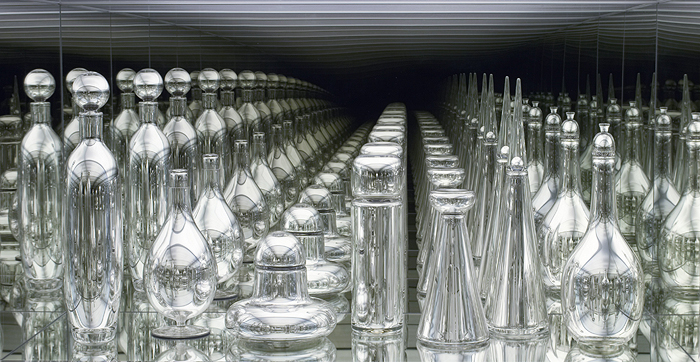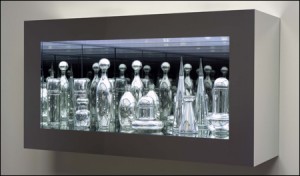Josiah McElheny has been around in the art world for a while, but I confess that the first time he really registered with me was last year, when I saw Endlessly Repeating Twentieth Century Modernism at the Museum of Fine Arts in Boston (detail, below right), followed quickly by a look at Czech Modernism (below left) at the Institute For Contemporary Art nearby. That was for the article I wrote last fall for The New York Times about contemporary art in Boston.
 I was intrigued, and that got me interested in writing about him, which led to my article about him in yesterday’s New York Times. I confess that I was one of the people Helen Molesworth, chief curator at ICA and a long-time backer of McElheny, was talking about in this passage, drawn from a catalogue essay:
I was intrigued, and that got me interested in writing about him, which led to my article about him in yesterday’s New York Times. I confess that I was one of the people Helen Molesworth, chief curator at ICA and a long-time backer of McElheny, was talking about in this passage, drawn from a catalogue essay:
If part of Josiah’s agenda is to try and think through the relations between the social contract and abstraction, then I’d like to talk about the kinds of experiences I find people have of Czech Modernism….The piece is comprised of mirrored vases housed in a mirrored vitrine that allows you to see an endlessly reflected image of the vases––a truly spectacular mise en abyme––and yet you do not see yourself. …for the most part, what people experience in response to this object are feelings of profound pleasure, amazement, and wonder. Yet when I talk about Czech Modernism publicly and discuss my sense of dread and horror, which is what the object engenders in me, when I describe a world of infinitely reproducible objects that are unfailingly the same, in which no human agent exists …
I find that I have to be gentle, I have to lead people to the idea slowly, because if I begin there, the crash, the affective letdown, is so hard.
…it’s not hard to get people to realize the dark implications of the piece. If this is a model of the social, then it is not a place where you want to live. That being said, I’ve watched a lot of people dispense with the darkness of the work almost immediately on assimilating it, and move back into the much more comforting place of wonder. So, for all of the sculpture’s explorations of the roads of modernism not taken, for all of its querying of utopianism, there’s a deep strain of foreboding in it. The work can be quite dark, as it intimates that the thing that you want is also the thing that is unsustainable….helplessness.
 When I discussed these modernity pieces with McElheny, he said: “To me those pieces are a failure. I misread how they would be perceived.” He called them his “most successful failures,” and added “I was disappointed that most people didn’t think what I thought they would.”
When I discussed these modernity pieces with McElheny, he said: “To me those pieces are a failure. I misread how they would be perceived.” He called them his “most successful failures,” and added “I was disappointed that most people didn’t think what I thought they would.”
But here’s the thing: McElheny knows that he is trying to embed sophisticated ideas into simple objects, and he volunteered to me that “There could be a big gap between what I’m talking about and what I’m doing. I accept that absolutely.” In other words, the viewer may not be entirely at fault.
A little later in our discussions, he added this: “I am an artist, so I get to be irresponsible in the way I am responsible to my own desires. That’s the gift and the terror of it. I don’t think artists should run the world. We should represent quixotic, imaginative thinking.”
I like that.
UPDATE: Cleaning out some of my reporting notes, I found a few other comments from some who knows McElheny’s work well but didn’t want to be quoted by name. They are revealing, though, so I wanted to share them:
- He wants the work to be seductive, beautiful and compelling purely as an object, but an object imbued with content has a much deeper life. It has a life of its own. Â
- He is interested in our obsession that histories are true, with singular meanings. There are layers, and his work makes us responsible for finding out the cracks in history.
- You’re trapped by the physical seduction, but then you have to realize that there are all these layers and you say, “now I have to know that.”
Photo Credits: Courtesy of the Museum of Fine Arts, Boston (top); ICA (bottom)
